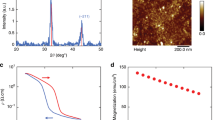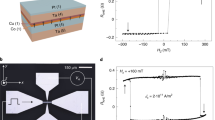Abstract
The interplay between spin, charge and orbital degrees of freedom has led to the development of spintronic devices such as spin–torque oscillators and spin-transfer torque magnetic random-access memories. In this development, spin pumping represents a convenient way to electrically detect magnetization dynamics1,2,3,4,5,6. The effect originates from direct conversion of low-energy quantized spin waves in the magnet, known as magnons, into a flow of spins from the precessing magnet to adjacent leads. In this case, a secondary spin–charge conversion element, such as heavy metals with large spin Hall angle4,5,6 or multilayer layouts7, is required to convert the spin current into a charge signal. Here, we report the experimental observation of charge pumping in which a precessing ferromagnet pumps a charge current, demonstrating direct conversion of magnons into high-frequency currents via the relativistic spin–orbit interaction. The generated electric current, unlike spin currents generated by spin-pumping, can be directly detected without the need of any additional spin–charge conversion mechanism. The charge-pumping phenomenon is generic and gives a deeper understanding of its reciprocal effect, the spin orbit torque, which is currently attracting interest for their potential in manipulating magnetic information.
This is a preview of subscription content, access via your institution
Access options
Subscribe to this journal
Receive 12 print issues and online access
$259.00 per year
only $21.58 per issue
Buy this article
- Purchase on Springer Link
- Instant access to full article PDF
Prices may be subject to local taxes which are calculated during checkout



Similar content being viewed by others
References
Mizukami, S., Ando, Y. & Miyazaki, T. The study on ferromagnetic resonance linewidth for NM/80NiFe/NM (NM = Cu, Ta, Pd and Pt) films. Jpn. J. Appl. Phys. 40, 580–585 (2001).
Heinrich, B. et al. Dynamic exchange coupling in magnetic bilayers. Phys. Rev. Lett. 90, 187601 (2003).
Costache, M. V., Sladkov, M., Watts, S. M., van der Wal, C. H. & van Wees, B. J. Electrical detection of spin pumping due to the precessing magnetization of a single ferromagnet. Phys. Rev. Lett. 97, 216603 (2006).
Mosendz, O. et al. Quantifying spin Hall angles from spin pumping: experiments and theory. Phys. Rev. Lett. 104, 046601 (2010).
Kajiwara, Y. et al. Transmission of electrical signals by spin–wave interconversion in a magnetic insulator. Nature 464, 262–267 (2010).
Sandweg, C. W. et al. Spin pumping by parametrically excited exchange magnons. Phys. Rev. Lett. 106, 216601 (2011).
Sánchez, J. C. R. et al. Spin-to-charge conversion using Rashba coupling at the interface between non-magnetic materials. Nature Commun. 4, 2944 (2013).
Tserkovnyak, Y., Brataas, A., Bauer, G. E. W. & Halperin, B. I. Nonlocal magnetization dynamics in ferromagnetic heterostructures. Rev. Mod. Phys. 77, 1375–1421 (2005).
Ralph, D. C. & Stiles, M. D. Spin transfer torques. J. Magn. Magn. Mater. 320, 1190–1216 (2008).
Bernevig, B. A. & Vafek, O. Piezo-magnetoelectric effects in p-doped semiconductors. Phys. Rev. B 72, 033203 (2005).
Manchon, A. & Zhang, S. Theory of nonequilibrium intrinsic spin torque in a single nanomagnet. Phys. Rev. B 78, 212405 (2008).
Manchon, A. & Zhang, S. Theory of spin torque due to spin–orbit coupling. Phys. Rev. B 79, 094422 (2009).
Garate, I. & MacDonald, A. H. Influence of a transport current on magnetic anisotropy in gyrotropic ferromagnets. Phys. Rev. B 80, 134403 (2009).
Hals, K. M. D., Brataas, A. & Tserkovnyak, Y. Scattering theory of charge-current-induced magnetization dynamics. Europhys. Lett. 90, 47002 (2010).
Pesin, D. A. & MacDonald, A. H. Quantum kinetic theory of current-induced torques in Rashba ferromagnets. Phys. Rev. B 86, 014416 (2012).
Wang, X. H. & Manchon, A. Diffusive spin dynamics in ferromagnetic thin films with a Rashba interaction. Phys. Rev. Lett. 108, 117201 (2012).
Hals, K. M. D. & Brataas, A. Phenomenology of current-induced spin–orbit torques. Phys. Rev. B 88, 085423 (2013).
Chernyshov, A. et al. Evidence for reversible control of magnetization in a ferromagnetic material by means of spin–orbit magnetic field. Nature Phys. 5, 656–659 (2009).
Endo, M., Matsukura, F. & Ohno, H. Current induced effective magnetic field and magnetization reversal in uniaxial anisotropy (Ga,Mn)As. Appl. Phys. Lett. 97, 222501 (2010).
Fang. D. et al. Spin–orbit-driven ferromagnetic resonance. Nature Nanotech. 6, 413–417 (2011).
Kurebayashi, H. et al. An antidamping spin–orbit torque originating from the Berry curvature. Nature Nanotech. 9, 211–217 (2014).
Miron, I. M. et al. Current-driven spin torque induced by the Rashba effect in a ferromagnetic metal layer. Nature Mater. 9, 230–234 (2010).
Miron, I. M. et al. Fast current-induced domain-wall motion controlled by the Rashba effect. Nature Mater. 10, 419–423 (2011).
Miron, I. M. et al. Perpendicular switching of a single ferromagnetic layer induced by in-plane current injection. Nature 476, 189–193 (2011).
Garello, K. et al. Symmetry and magnitude of spin–orbit torques in ferromagnetic heterostructures. Nature Nanotech. 8, 587–593 (2013).
Kim, J. et al. Layer thickness dependence of the current-induced effective field vector in Ta |CoFeB| MgO. Nature Mater. 12, 240–245 (2013).
Fan, X. et al. Observation of the nonlocal spin-orbital effective field. Nature Commun. 4, 1799 (2013).
Onsager, L. Reciprocal relations in irreversible processes. Phys. Rev. 37, 405 (1931).
Tatara, G., Nakabayashi, N. & Lee, K. J. Spin motive force induced by Rashba interaction in the strong sd coupling regime. Phys. Rev. B 87, 054403 (2013).
Jungwirth, T., Sinova, J., Masek, J., Kucera, J. & MacDonald, A. H. Theory of ferromagnetic (III,Mn)V semiconductors. Rev. Mod. Phys. 78, 809 (2006).
Liu, L. Q., Moriyama, T., Ralph, D. C. & Buhrman, R. A. Spin–torque ferromagnetic resonance induced by the spin Hall effect. Phys. Rev. Lett. 106, 036601 (2011).
Liu, X. Y. & Furdyna, J. K. Ferromagnetic resonance in Ga1–xMnxAs dilute magnetic semiconductors. J. Phys. Condens. Matter 18, R245–R279 (2006).
Acknowledgements
A.F. acknowledges support from a Hitachi Research Fellowship and C.C. from a Junior Research Fellowship at Gonville and Caius College. V.N. acknowledges MSMT grant no. LM2011026.
Author information
Authors and Affiliations
Contributions
K.H. and A.B. developed the theory and suggested the experiment. C.C. and A.J.F. developed the experimental technique and performed the experimental work. V.N. grew the materials. A.I. performed the nanofabrication. C.C., K.H., A.B. and A.F. wrote the manuscript. All authors discussed the results and commented on the paper.
Corresponding author
Ethics declarations
Competing interests
The authors declare no competing financial interests.
Supplementary information
Supplementary information
Supplementary Information (PDF 996 kb)
Rights and permissions
About this article
Cite this article
Ciccarelli, C., Hals, K., Irvine, A. et al. Magnonic charge pumping via spin–orbit coupling. Nature Nanotech 10, 50–54 (2015). https://doi.org/10.1038/nnano.2014.252
Received:
Accepted:
Published:
Issue Date:
DOI: https://doi.org/10.1038/nnano.2014.252
This article is cited by
-
Suppression of spin rectification effects in spin pumping experiments
Scientific Reports (2022)
-
Optical conversion of pure spin currents in hybrid molecular devices
Nature Communications (2017)
-
Dynamical amplification of magnetoresistances and Hall currents up to the THz regime
Scientific Reports (2017)
-
Femtosecond control of electric currents in metallic ferromagnetic heterostructures
Nature Nanotechnology (2016)
-
Charges ride the spin wave
Nature Nanotechnology (2015)



